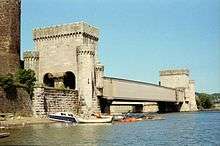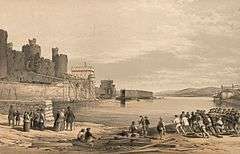Conwy Railway Bridge
| Conwy Railway Bridge Pont Rheilffordd Conwy | |
|---|---|
 Conwy Railway Bridge across the River Conwy | |
| Coordinates | 53°16′49″N 3°49′25″W / 53.280278°N 3.823611°WCoordinates: 53°16′49″N 3°49′25″W / 53.280278°N 3.823611°W |
| Carries | North Wales Coast Line |
| Crosses | River Conwy |
| Locale | Conwy |
| Maintained by | Network Rail |
| Heritage status | Grade I listed |
| Cadw | 3236 |
| Followed by | Conwy Suspension Bridge |
| Characteristics | |
| Design | Tubular bridge |
| Material |
Wrought iron Limestone |
| Total length | 463 ft (141 m) |
| Width | 42 ft (13 m) |
| Clearance below | 46 ft (14 m) (low tide) |
| Design life | 1899: cast iron piers are added to reduce the load on the tubes and permit heavier trains |
| History | |
| Architect | Francis Thompson |
| Engineering design by |
Robert Stephenson in collaboration with William Fairbairn and Eaton Hodgkinson |
| Constructed by | William Evans |
| Construction begin | 1846 |
| Construction end | 1848 |
| Opened | 1849 |
The Conwy Railway Bridge carries the North Wales coast railway line across the River Conwy between Llandudno Junction and the town of Conwy. The wrought iron tubular bridge, which is now Grade I listed, was built in the 19th century by Robert Stephenson. It is the last surviving example of this type of design by Stephenson after the Britannia Bridge across the Menai Strait was destroyed in a fire in the 1970s.
History

The bridge was constructed to carry the Chester and Holyhead Railway across the River Conwy. Robert Stephenson, in collaboration with William Fairbairn and Eaton Hodgkinson, provided the engineering plans. Before their involvement it was intended to be a suspension bridge, complementing the 1826 Conwy Suspension Bridge by Thomas Telford. However, after Stephenson's appointment as chief engineer, the design changed because a suspension bridge was considered not robust enough to carry trains. Stephenson and his collaborators invented wrought-iron box-girder construction in order to bridge the River Conwy in a single span.
The project's architect was Francis Thompson, who dressed the pylons at either end as barbicans, complete with crenellated turrets, arrow slits and bartizans to complement the adjacent Conwy Castle, an Edwardian fortification that had stood on the promontory since the late 13th century. The bridge contractor was a William Evans. Construction began in 1846. The ironwork was constructed by Easton & Amos.[1] Steam-powered hydraulic engines were used to lift the wrought-iron girders and beams into place from barges moored in the river.
The bridge was officially opened in 1849, although it had been completed in 1848. Stephenson wanted to confirm through testing that the structure, the first tubular crossing to be built, would be capable of carrying the weight of a locomotive and its rolling stock. The testing was performed by Fairbairn. The successful results endorsed the construction of the Britannia Bridge. In 1899 the tubular sections were reinforced with additional cast iron columns to reduce the load on the span across the river.
Legacy
Conwy railway bridge remains the only surviving example of a tubular bridge designed by Stephenson. The original Britannia Bridge was consumed by fire in 1970. Although it was subsequently rebuilt, it was reconstructed as a two-tier truss arch bridge made from steel and concrete.
The bridge is maintained by Network Rail because it is still part of the UK rail system. Its heritage is managed by Cadw.
See also
Notes
- Citations
- Bibliography
- Hebert, Luke (1849). The Iron Tubular Bridge Over The River Conway. The Engineer's and Mechanic's Encyclopaedia. Vol 1 (2nd ed.). Thomas Kelly: London.
External links
| Wikimedia Commons has media related to Conwy Railway Bridge. |
- Aerial photo
- Local tourist information
- General description of the Britannia and Conway tubular bridges on the Chester and Holyhead Railway, 1849, from Google Book Search